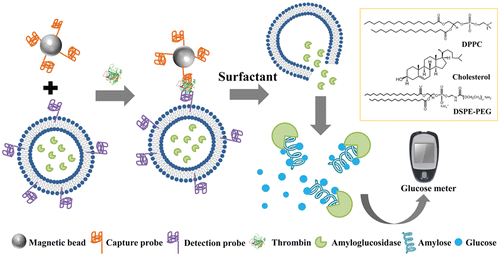Using glucose monitors to detect other diseases

Diagnosing disease can be highly technical, costly and time-consuming, which are all challenges that become particularly problematic in low-income and remote locations. Now scientists are reporting in the journal ACS Applied Materials & Interfaces a new way to repurpose portable glucose monitors to harness these simple devices' practicality and low cost for the detection of other diseases.
There are many benefits to diagnosing disease quickly. Treatment can start earlier, which can lead to better outcomes. It saves time and money. It can also minimize patients' anxiety as they wait for results. But rapid diagnoses aren't always possible using current technology. The personal glucose monitor, however, is one medical testing device that can deliver results rapidly. Building on its success, scientists have started repurposing it to test for other substances, such as cocaine or Salmonella bacteria in milk. But the methods they used so far required complicated and time-consuming steps. Chaoyong James Yang and colleagues wanted to take a simpler approach and apply it to biological disease markers.
The researchers started with tiny spherical pouches called liposomes and filled them with enzymes that produce glucose. In the presence of a target molecule, the liposomes were designed to burst open and cause an increase of glucose in the test solution. The researchers tried it with thrombin, a protein that can indicate restricted blood flow or heart disease. A commercial glucose monitor accurately detected the levels of glucose, which corresponded to the amount of thrombin in samples. In addition, the researchers say their method could be used to detect other disease-associated proteins.
More information: Bingqian Lin et al. Enzyme-Encapsulated Liposome-Linked Immunosorbent Assay Enabling Sensitive Personal Glucose Meter Readout for Portable Detection of Disease Biomarkers, ACS Applied Materials & Interfaces (2016). DOI: 10.1021/acsami.6b00777
Abstract
There is considerable demand for sensitive, selective, and portable detection of disease-associated proteins, particularly in clinical practice and diagnostic applications. Portable devices are highly desired for detection of disease biomarkers in daily life due to the advantages of being simple, rapid, user-friendly, and low-cost. Herein we report an enzyme-encapsulated liposome-linked immunosorbent assay for sensitive detection of proteins using personal glucose meters (PGM) for portable quantitative readout. Liposomes encapsulating a large amount of amyloglucosidase or invertase are surface-coated with recognition elements such as aptamers or antibodies for target recognition. By translating molecular recognition signal into a large amount of glucose with the encapsulated enzyme, disease biomarkers such as thrombin or C-reactive protein (CRP) can be quantitatively detected by a PGM with a high detection limit of 1.8 or 0.30 nM, respectively. With the advantages of portability, ease of use, and low-cost, the method reported here has potential for portable and quantitative detection of various targets for different POC testing scenarios, such as rapid diagnosis in clinic offices, health monitoring at the bedside, and chemical/biochemical safety control in the field.
Journal information: ACS Applied Materials and Interfaces
Provided by American Chemical Society




















